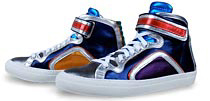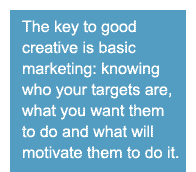
![]()
So you've done your research, defined your target audience, established your objectives and determined what your message should be. What should you look for in creative? Everybody knows it's important to have your message stand out from the background noise of the marketplace, so you want to see something splashy or funny or clever or exceptionally striking in some way, right?  Yes, but don't lose track of your basic marketing: the key is understanding your target audience. What motivates a teenager to buy a pair of sneakers is very different from what motivates a corporate engineer to purchase electronic parts or what motivates a senior citizen to choose a retirement home.
Yes, but don't lose track of your basic marketing: the key is understanding your target audience. What motivates a teenager to buy a pair of sneakers is very different from what motivates a corporate engineer to purchase electronic parts or what motivates a senior citizen to choose a retirement home.  If you understand who your targets are, what you want them to do and what will motivate them to do it (demographics, objectives and psychographics), you can craft the form and content of your message to have maximum influence on their behavior.
If you understand who your targets are, what you want them to do and what will motivate them to do it (demographics, objectives and psychographics), you can craft the form and content of your message to have maximum influence on their behavior.
This means that just being splashy, or funny, or striking isn't enough. You have to do these things plus deliver the right message to motivate the response you want. That's what creates sales results - the bottom line of any communications program. Believe me, it's very easy to get caught up in a terrific creative concept and forget that it's not quite the right message. That's the kind of creative that wins awards but, unfortunately, loses customers. Still, seeing awards down the line, some agencies will try to defend the concept as good creative. Which begs the question: does "good creative" mean good for you, or good for the agency?
Without doubt, successful advertising still involves its share
of smoke and mirrors (the intuitive response of your creative team) to tantalize your target audience. But effective programs still evolve primarily from marketing experience, psychology and
good research.
I should also mention that there are times when an exciting creative concept is just so much dead weight. In the B2B world, for example, your customer may be a professional buyer, whose job it is to find and try products just like yours. In that case, there is no need to create a desire for the product with a clever twist - the best approach will be a straightforward presentation of the features and benefits. A good buyer will know exactly what he's looking for, and the more clearly and simply you can state your case the better.
As you scroll through the case histories in this section, remember that the story is not in the visuals (although some of them are pretty cool, if I do say so myself). The story is in the description of how the specific creative approach solves the specific marketing problem and why it's a better solution than something else which may have more raw visual appeal.
As strange as it seems to say it, even simple design is not a simple design problem any more - it's a marketing problem first. And if you always keep that in mind, your marketing efforts will be the better for it!